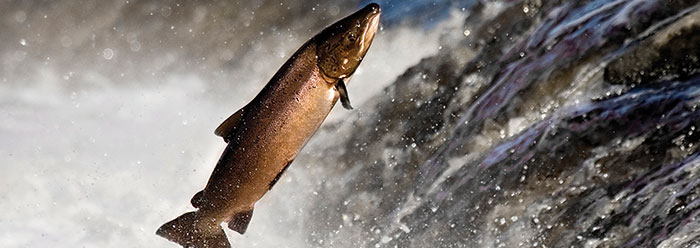by Brian Thomas, M.S., & Phil Gaskill *
Have you ever been lost and longed for a map and compass? God designed people in His image so that we can create navigational aids. But what if you were a salmon that had to swim to a precise spot hundreds of miles away—all without a guide? Fortunately, migrating salmon use at least three navigational tools that work in synchrony and demonstrate their marvelous design.
How do these fish find their way to the exact same place of their birth? By the mid-1980s, experiments had shown that salmon detect and remember the unique water chemistry of their origins. Young salmon “have a flexible system for learning olfactory waypoints at appropriate times and places.”1 When heading downstream to the ocean, they record the water chemistry along the way so that they can later retrace their path in reverse.
Salmon use their extremely precise olfactory senses to zoom in on the exact location of their spawning ground, but they first have to navigate to the general area.
In a 1998 experiment, researchers transported hatchery-raised sockeye salmon, some of them blind, several kilometers away from the area of their birth in Japan’s Lake Toya. The sighted fish quickly navigated right back to their place of origin, while the blind fish swam randomly for most of the day. The authors wrote, “It is surprising that the fish identifies his position in open water and the direction of the natal [birth] area with such a high degree of accuracy.”2
So, the second navigational tool—the primary one for salmon—is a polarized light compass. A 2003 study of salmon’s polarized light compass stated, “When the sun is lower on the horizon…the position of the sun can be determined unambiguously by the distribution of polarized light.”3 Exactly how the fish determine the distribution of polarized light, measure its angle, and use that information to navigate is not yet known.
But how would salmon navigate at night or under cloud cover? Like any good engineer, the Lord Jesus designed salmon with redundant technologies. Salmon possess a third navigational tool—a magnetic compass.
These amazing fish can navigate by comparing their directional heading to a magnetic map of their surroundings. Authors of a 2005 study had a hard time imagining that a single device could do all this. They wrote, “Likewise, a mechanism designed to record tiny changes in intensity can, at the same time, hardly measure the direction of the magnetic field with great precision.”4 However, a 2012 report showed that salmon’s magnetic receptors detect both!
Single cells act like compass needles, having a microscopic collection of magnetite crystals at one end. They constantly pull toward magnetic field lines, thereby stressing surrounding detector cells as the salmon turns. According to these authors, the cells in this single system are “therefore not only sufficient to detect the direction of magnetic north but also likely to form the basis of an accurate magnetic sensory system with which to extract positional information.”5
Nobody would think that the laws of chemistry and environmental changes could whisk together a map and compass, and everyone knows that a handheld GPS was purposefully designed. Likewise, the salmon’s miniaturized integrated GPS technologies are so advanced that they could only be attributed to a Genius who transcends man and nature.
References
- Dittman, A. and T. Quinn. 1996. Homing in pacific salmon: Mechanisms and ecological basis. Journal of Experimental Biology. 199: 83-91.
- Ueda, H. et al. 1998. Lacustrine sockeye salmon return straight to their natal area from open water using both visual and olfactory cues. Chemical Senses. 23: 207-212.
- Parkyn, D., J. Austin and C. Hawryshyn. 2003. Acquisition of polarized-light orientation in salmonids under laboratory conditions. Animal Behavior. 65: 893-904.
- Wiltschko, W. and R. Wiltschko. 2005. Magnetic orientation and magnetoreception in birds and other animals. Journal of Comparative Physiology A. 191 (8): 675-693.
- Eder, H. et al. 2012. Magnetic characterization of isolated candidate vertebrate magnetoreceptor cells. Proceedings of the National Academy of Sciences. 109 (30): 12022-12027.
* Mr. Thomas is Science Writer at the Institute for Creation Research, and Mr. Gaskill is Science Writer for Cramer Fish Sciences.
Cite this article: Thomas, B. and P. Gaskill. 2012. Swimming Upstream: Navigation Systems in Migrating Salmon. Acts & Facts. 41 (10): 17.




